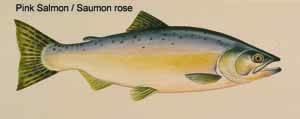Pink Salmon
Latin Name
Oncorhynchus gorbuscha
Group Name
Diadromous
Habitat
The most abundant among the Pacific salmon, pink salmon are found throughout the northern Pacific. In the eastern Pacific, their range stretches from northern Alaska to southern California. Pink salmon seem to be colonizing Canada's western arctic and are now reported as far east as the Mackenzie River. In the west, they range from the Siberian coast to the waters off Korea and Japan. Pink salmon are also found in the Russian arctic as far as the White Sea. In the Great Lakes, pink salmon occur in Lake Erie to eastern Lake Ontario and in Lakes Huron and Superior, where they were accidentally introduced in the 1950s. Pink salmon, like all of the Pacific salmon, are born in freshwater rivers and streams but do most of their growing in the ocean. After swimming far out into the Pacific Ocean and Bering Sea, pink salmon return faithfully to their birthplaces to spawn.
Species Description
Pink salmon are the smallest of the Pacific salmon, averaging between 1.5 to 5 kilograms and growing to about 50 centimetres in length. They are silver with a streamlined body and a slightly indented tail. Pink salmon have tiny scales and their tail is heavily marked with large oval spots. Sea-run pinks have blue or bluish-green backs. During spawning, males grow a large hump and both sexes change from their blue and silver colouring to pale grey. Males' dorsal area darkens and their flanks become red with brownish-green patches during spawning. Spawning females undergo a similar but less pronounced colour change. They have a fixed, two-year lifespan-after spending 18 months in the ocean or Great Lakes, maturing fish return to the rivers where they were born to spawn and die.
- Date modified:
